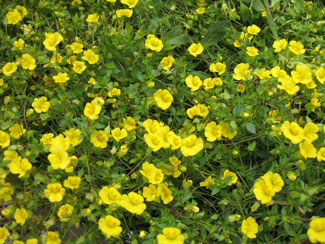Resource Library
Plant of the Week: Magic Carpet, Yellow
Magic Carpet, Yellow -- ‘Magic Carpet Yellow’ is one of the newest introductions of the new gardening sensation known as Mecardonia or Baby Jump Up. (Image courtesy Gerald Klingaman)
‘Magic Carpet Yellow’
Latin: Mecardonia
A new garden annual caught my attention this season, a plant from Sakata Seed Company
called Mecardonia ‘Magic Carpet Yellow.’ This little trailing plant only grows about
4 inches tall but has flowered non-stop from early spring when it was planted and
continues to bloom during the cool nights of mid October.Checking my photo files I discovered an image of a different, but similar, cultivar marketed as ‘Gold Flake’ from the Proven Winners people released in 2006.
Mecardonia is a genus consisting of a dozen currently recognized species native to our most southerly states (including Arkansas) and ranges through Mexico, Central America and into parts of western South America. It is now classified as a member of the plantain family but before DNA analysis was considered a member of the Scrophulariaceae family.
The Mecardonia being offered up in the greenhouse trade are hybrids between M. caespitosa x M. dianthera. Plants reach about 4 inches in height with a free branching, prostrate form and spread to a foot or more across. Leaves are bright green, rounded to elliptic in outline, with serate margins and to .75 inch in length.
The bright yellow flowers are bell shaped to five-eighths of inch across with five petals, the upper two of which are fused together. Flowers are produced singly in the leaf axils, leading to the common name of axilflower for the genus. Blooms of this hybrid are sterile so flowers are produced non-stop during the growing season. A new Proven Winners introduction called ‘Gold Dust’ has somewhat smaller flowers than the original introductions, but produces them in greater abundance.
The original Mecardonia hybrid was made in May of 1999 in Japan by Ushio Sckazaki, a plant breeder credited with revitalizing interest in petunias and, by many, is considered the foremost petunia breeder in the world. Sckazaki received his plant patent for Mecardonia in 2003, with the first generation of plants being vegetatively propagated.
Sckazaki found himself in Brazil working to improve the quality of a cheap white wine his employer was producing when he stumbled upon a wild petunia covered with thousands of blooms. He collected seed and, upon returning to Japan, developed the Surfina petunias that proved to be an international success and providing him the resources to establish his own flower breeding and research company. Aside from his hard work and creativity, much of his success, according to Rick Schoellhorn with Proven Winners, has been his ability to seek out wild species and combine them with existing cultivars to introduce new and novel plants for the marketplace.
Mecardonia is equally well suited for use in beds, hanging baskets or mixed containers. It has moderate drought tolerance but if it gets too dry blooming will suffer. Plants have great heat tolerance and bloom regardless of how hot it gets at night, a trait lacking in many plants that quit blooming during the summer. For best results they should be planted in full sun or only light shade. As the plant is sterile, deadheading is not needed. Plants are reported to overwinter as far north as Dallas, making them hardy to about 20 degrees Fahrenheit.
By: Gerald Klingaman, retired
Retired Extension Horticulturist - Ornamentals
Extension News - October 25, 2013
